Suicide involves intentional bodily harm with the intention of causing death. Suicidal behavior encompasses thoughts about committing suicide, including those with a plan for implementation and those that occur without a specific plan. The majority of individuals attempting suicide are psychiatric patients (1). Approximately 21% of individuals diagnosed with schizophrenia attempt suicide, while 39% of those with unipolar and bipolar depression make such attempts (2, 3). It is acknowledged that not all suicidal thoughts lead to actual attempts (4). However, the presence of suicidal thoughts is recognized as a significant risk factor for attempting suicide. The number of suicidal thoughts significantly surpasses the number of attempts made by individuals (3). It is critical to highlight that suicidal behaviors, including thoughts without a tendency to be realized, thoughts with a tendency to be realized, and suicide attempts, constitute a complex process. Individuals attempting suicide usually have previously experienced both types of thoughts, which means they were unable to seek adequate assistance (5, 6). There is a need for precise methods to differentiate individuals at risk of attempting suicide among those reporting such thoughts (3). Scientific research suggests a relationship between the presence and intensity of suicidal behavior and changes in the concentration of certain biochemical parameters, including oxidative stress and inflammatory factors, in the body (5). Although the significance of these disorders in chronic mental diseases is emphasized, the role of oxidative stress in psychiatry remains unclear (5).
Oxidative stress (OS) occurs when there is an excess production of reactive oxygen species (ROS) or reactive nitrogen species (RNS), leading to a diminished antioxidant capacity in the body (3, 4). OS is implicated in causing cell and DNA damage (4). Research indicates a connection between inflammatory neurotoxicity, nitrooxidative stress, and suicidal behavior. The brain, being an organ with high oxygen consumption vital for the functioning of the central nervous system (CNS), is particularly vulnerable to oxidative stress (7). Depression and schizophrenia are prevalent chronic mental disorders often associated with frequent hospitalizations. Numerous studies suggest that individuals post-hospitalization are 28 to 49% more likely to attempt suicide (6). Depression is linked to oxidative stress parameters, evident through the presence of markers for lipid peroxidation and inadequate antioxidant protection (8). Growing evidence highlights the association between inflammation and schizophrenia, consequently indicating the presence of oxidative stress parameters. Individuals undergoing treatment for schizophrenia exhibit reduced levels of glutathione (GSH), superoxide dismutase (SOD), and catalase (CAT) (9). Neurochemical changes occurring during psychosis trigger the OS process, leading to the overactivation of NMDA (N-methyl-D-aspartate receptor) glutamate cells and altering the function of dopamine receptors (9).
In light of recent scientific findings, the examination of oxidative stress markers in psychiatric patients exhibiting suicidal tendencies appears to be warranted. Consequently, this study aimed to evaluate oxidative stress parameters in individuals with depression and schizophrenia, considering gender differences, and manifesting suicidal behavior, encompassing thoughts without a tendency to be realized, thoughts with a tendency to be realized, and suicide attempts. Realistically assessing the risk of suicide attempts is crucial for providing effective assistance to patients suffering from mental illness, ultimately aiming to reduce the mortality rate due to suicide in this population. Targeted efforts directed at individuals within the high-risk group represent one of the key avenues to mitigate the incidence of suicide (6).
2 Materials and methods2.1 Study groupThe study involved patients admitted to the Department of Psychiatry at the Medical University of Bialystok due to mental deterioration and diagnosed with unipolar depression or schizophrenia. From among the patients hospitalized in the ward, 120 individuals were selected who met the inclusion criteria and did not meet the exclusion criteria for the study. The inclusion criteria encompassed a diagnosis of depression or schizophrenia (see Figure 1) and patients aged between 20 and 50 years. Exclusion criteria included the use of psychoactive substances, the coexistence of central neurological system diseases (stroke, dementia, intellectual disability) and other severe somatic conditions. Patients included in the study were not receiving lithium treatments but were taking antipsychotic and antidepressant medications (olanzapine, aripiprazole, chlorpromazine, chlorprothixene, promazine, zuclopenthixol, quetiapine, risperidone, mirtazapine, sertraline, trazodone, venlafaxine, citalopram, sulpiride, mianserin, moclobemide, duloxetine, haloperidol). In the initial phase of the project, patients eligible for the study underwent the M.I.N.I 7.0.2 questionnaire (part B – suicidal thoughts, self-harm, suicidal behavior). Based on the obtained results, patients were categorized into specific groups (Table 1). The assessment was conducted within the first 48 hours of the patient’s admission to the ward. In a cohort of 120 patients admitted to the hospital for depression or schizophrenia, the participants were categorized into eight groups: females without suicidal tendencies (G0F), females with suicidal thoughts without the tendency to act on them (G1F), females with suicidal thoughts with the tendency to act on them (G2F), females post suicide attempt (G3F), males without suicidal tendencies (G0M), males with suicidal thoughts without the tendency to act on them (G1M), males with suicidal thoughts with the tendency to act on them (G2M), and males post suicide attempt (G3M). Oxidative and antioxidant parameters related to oxidative stress were assessed in this study. 47.5% (n=57) of all the patients were women, while 52.5% (n=63) were men.
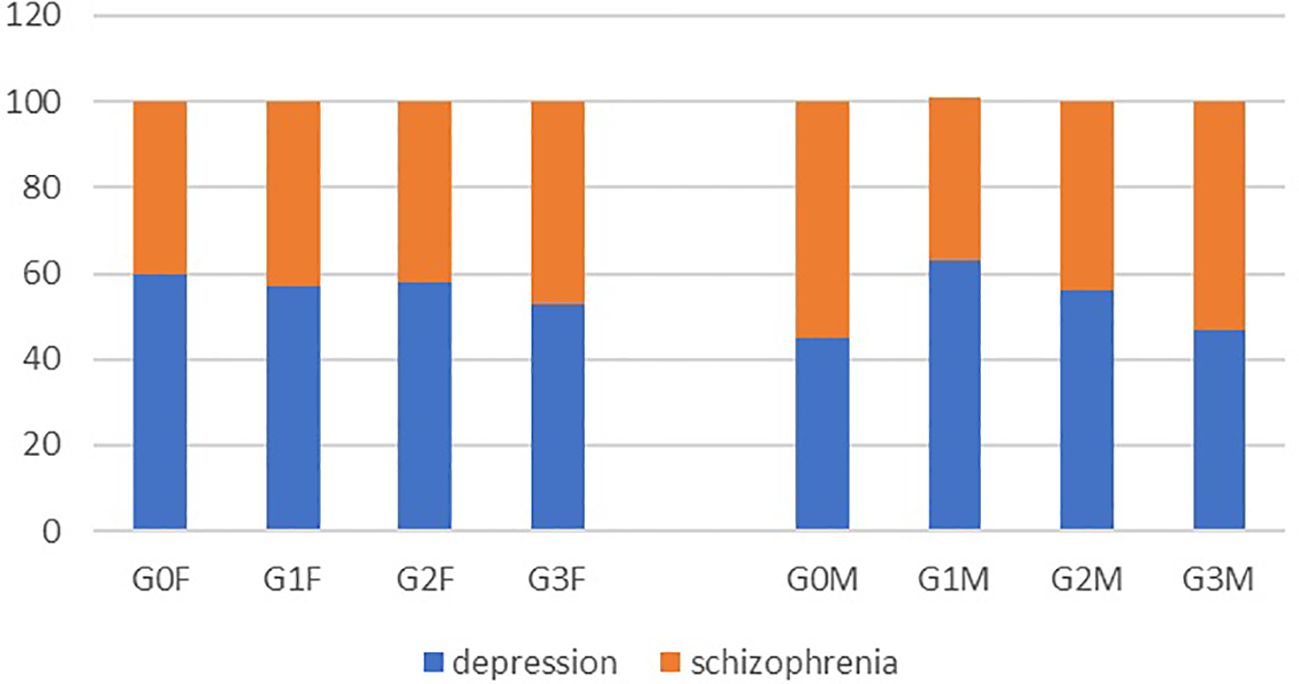
Figure 1 Characteristics of the examined patients in terms of diagnosis (depression and schizophrenia) in respective groups.

Table 1 Division of the subjects into respective groups.
Subsequently, the presentation of the characteristics of the examined patients was provided, focusing on the diagnosis of the disease (depression, schizophrenia) within each group (Figure 1).
The analysis of the frequency of hospitalizations among the patients participating in the study is illustrated in Figure 2.
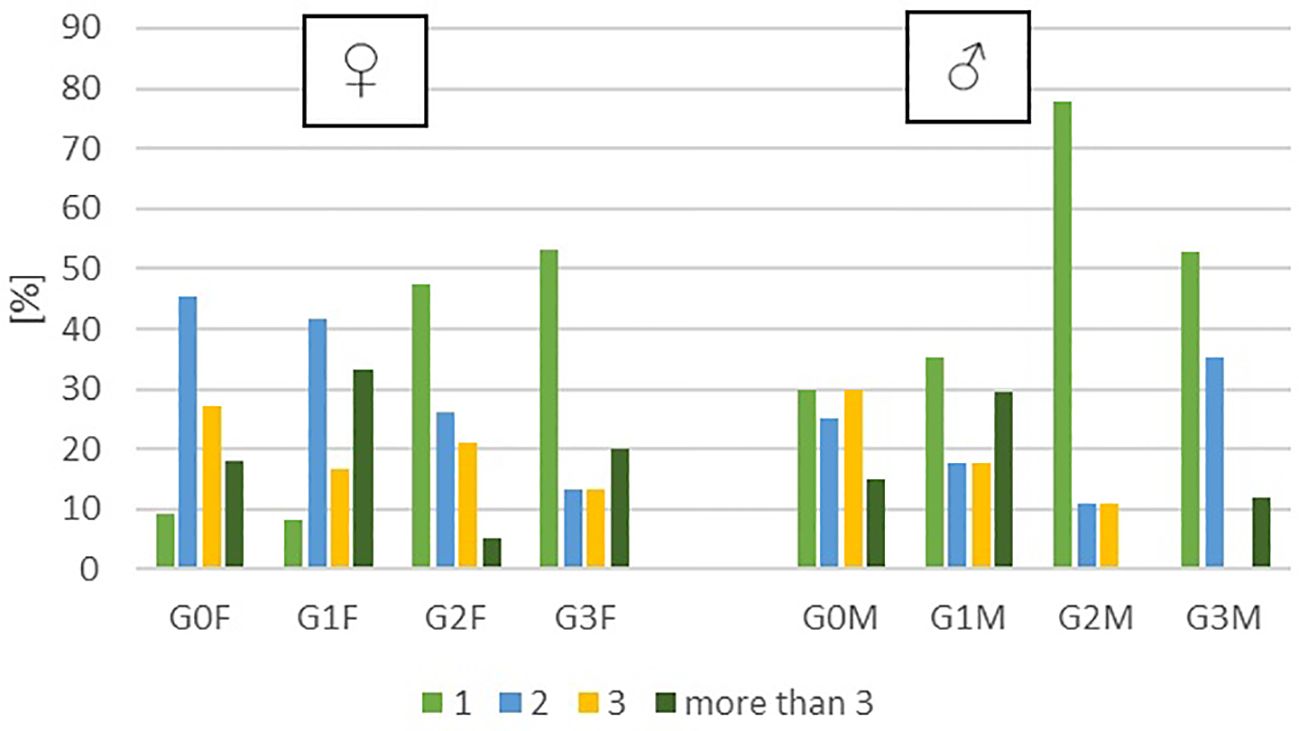
Figure 2 The number of hospitalizations in women and men in respective groups.
The majority of individuals assigned to the G3F and G3M categories made their suicide attempt for the first time (73% of female patients and 82% of male patients). There were no statistically significant differences between the groups in terms of the number of hospitalizations. Subsequently, in the second phase of the research, venous blood samples were collected from the patients for the purpose of conducting biochemical assessments, focusing on oxidative stress parameters.
2.2 Methodology of assessmentBlood samples for the study were collected within the first 48 hours of hospitalization, following a MINI 7.0.2 interview. Venous blood required for assessing the concentration (TOS, OSI, GSH, TAC, FRAP) and activity (GPx, SOD) of oxidative stress parameters was collected into K-3 EDTA s-monovette tubes in the collection room after an overnight fast. The tubes were labeled and coded for the study, then centrifuged at 3000 xg for 20 minutes at 4°C (MPV-351R). After plasma separation, the samples were stored at -80°C in Eppendorf tubes until assays were performed. The analyses were conducted utilizing a Sigma-Aldrich device with a 96-well microplate reader, and the absorbance/fluorescence of the plates was measured. The results were standardized to 1 mg of proteins, and a dual-sample approach was employed to validate the findings. The assessments were carried out at the Department of Hygiene, Epidemiology, and Ergonomics of the Medical University of Białystok.
The following oxidative stress metabolites were analyzed:
● TOS (total oxidation state – nmol H2O2 Equiv/mg protein) was assessed bichromatically by inducing the oxidation of Fe2+ to Fe3+ in the presence of oxidants within the sample (560/800 nm) (10);
● OSI (TOS/TAC ratio) was computed using the OSI = TOS/TAC formula (11);
● GPx (glutathione peroxidase – mU/mg protein) was determined by measuring NADPH coupled with the reduction of GSSH (12);
● SOD (Cu-Zn-superoxide dismutase - mU/mg protein) was assessed by gauging the inhibition rate of adrenaline oxidation (480 nm) (13);
● GSH (reduced glutathione - µg/mg protein) was derived from the standard curve for GSH solutions and expressed as g/mg protein, with sample absorbance at 412 nm (14);
● TAC (umol/mg protein) was assessed spectrophotometrically, wherein the TAC concentration was determined using the radical cation ABTS (2,2-azinobis-3-ethylbenzothiazoline-6-sulfonic acid) and Trolox (6-hydroxy-2,5,7,8 acid -tetramethylchroman-2-carboxylic acid) – at a wavelength of 660 nm (15);
● FRAP (umol/mg protein) was assessed colorimetrically. The formation of the colored iron complex tripyridyltriazine (Fe3+-TPTZ) resulted from the reduction of Fe2+ to Fe3+. The reaction occurred in an acidic medium with an absorbance of 592 nm (16);
The examination of the concentration and activity of specific parameters revealed statistically significant variances for the following markers: TOS, OSI, SOD, GSH, TAC, FRAP, and GPx within the entire cohort of subjects.
2.3 Statistical analysisThe study results were statistically analyzed using the STATISTICA 13.0 test and the R-project test. Statistical significance was considered at p<0.05. The normality of distribution was assessed using the Shapiro-Wilk test. To examine the hypothesis of the insignificance of differences between the medians of the studied variable in individual groups, the Kruskal-Wallis ANOVA test was employed. For a more detailed analysis, Dunn’s post-hoc test was utilized to compare the differences between groups.
3 ResultsThe evaluation of the levels of oxidative stress factors in the blood plasma of the subjects is outlined in Table 2.
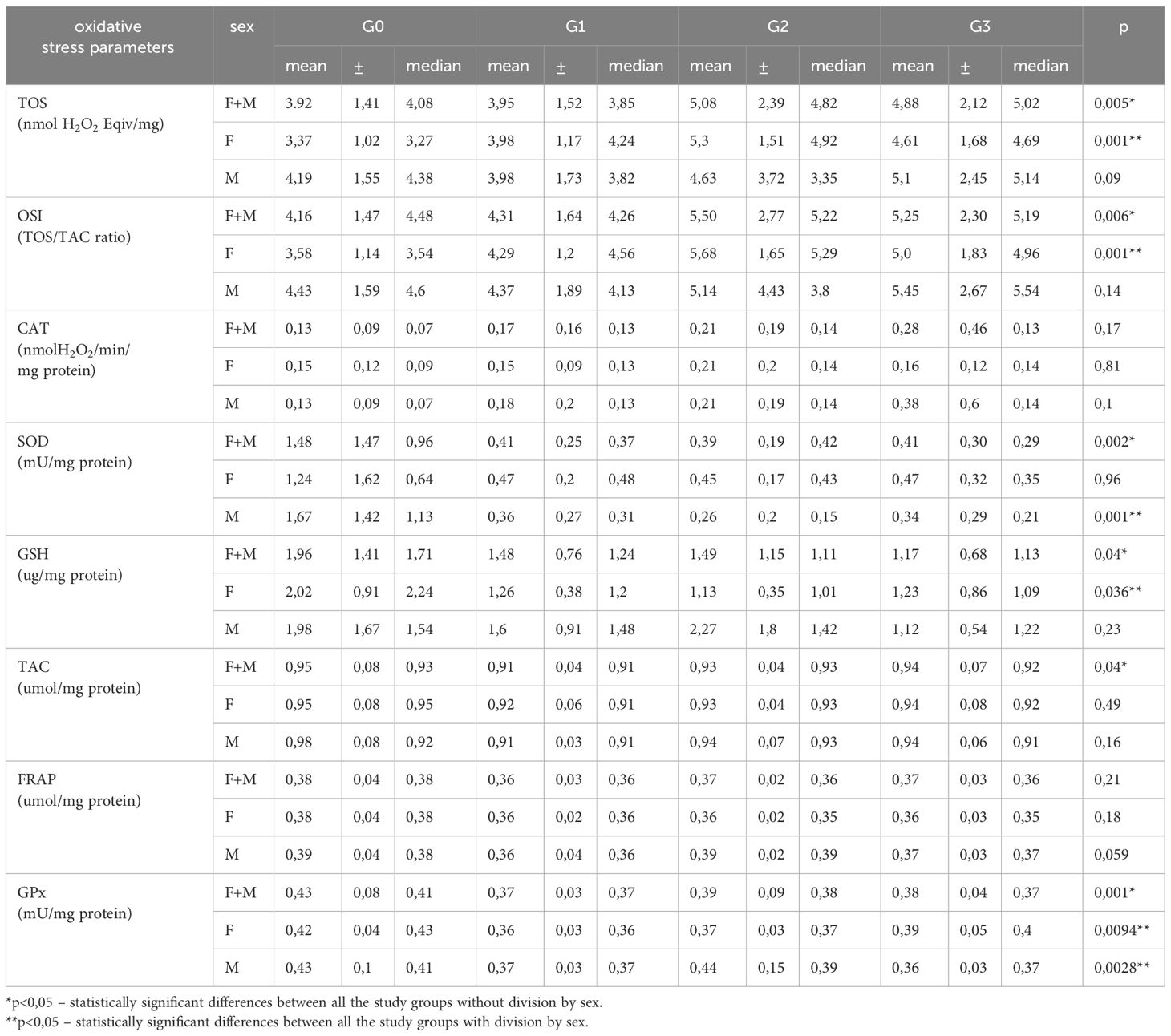
Table 2 Results of oxidative stress parameters in the blood plasma of the examined patients.
3.1 Redox biomarkers (TOS, OSI)The female cohort with depression and schizophrenia exhibited notable distinctions in TOS concentration (p=0.0011). The findings are illustrated in Figure 3.
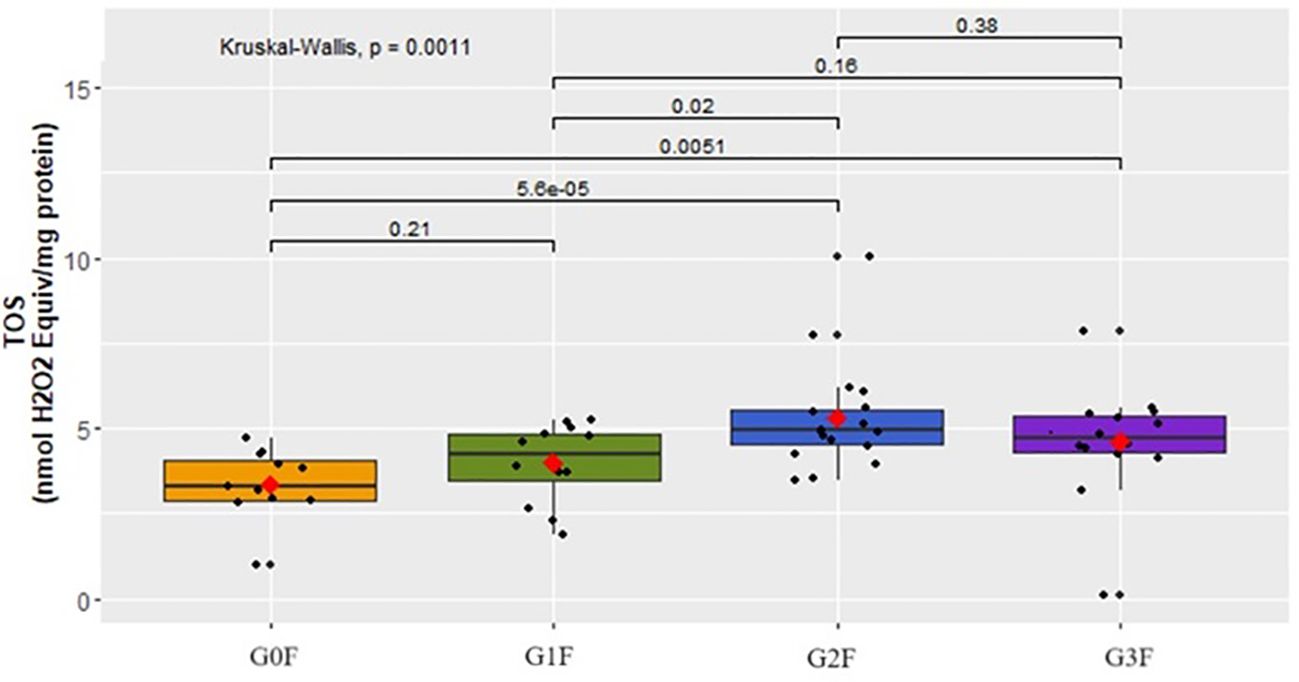
Figure 3 Analysis of TOS concentration (nmol H2O2 Equiv/mg protein) in the plasma of examined women in respective groups.
TOS concentrations increased in groups showing suicidal behavior (G1F: x¯=3.9 ± 1.17, G2F: x¯=5.3 ± 1.51, G3F: x¯=4.6 ± 1.68) compared to the control group (G0F: x¯=3.4 ± 1.02). Regarding the findings in women, a significant increase in Total Oxidant Status (TOS) levels was observed in those with suicidal thoughts and a tendency to act on them (G2F: x¯5.3 ± 1.51) compared to women with suicidal thoughts but no tendency to act on them (G1F: x¯=3.9 ± 1.17).
The analysis of TOS concentration in the male cohorts did not show statistically significant differences (Figure 4). Only a significant increase in TOS can be observed in the group of men after a suicide attempt (G3M: x¯=5.1 ± 2.45) compared to the group of men with suicidal thoughts but no tendency to act on them (G1M: x¯=3.98 ± 1.73).
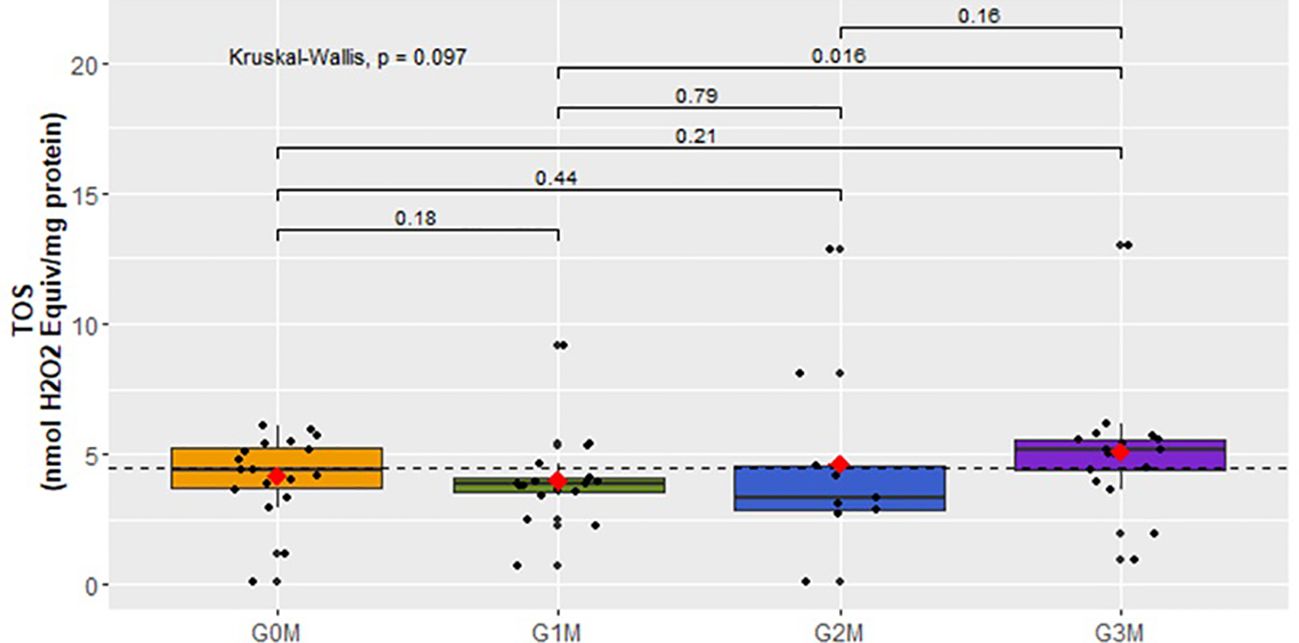
Figure 4 Analysis of TOS concentration (nmol H2O2 Equiv/mg protein) in the plasma of examined men in respective groups.
The concentration of OSI was evaluated in the female cohort, revealing statistically significant differences (Figure 5), with the parameter’s concentration increasing in tandem with the escalation of suicidal behaviors (p=0,001).
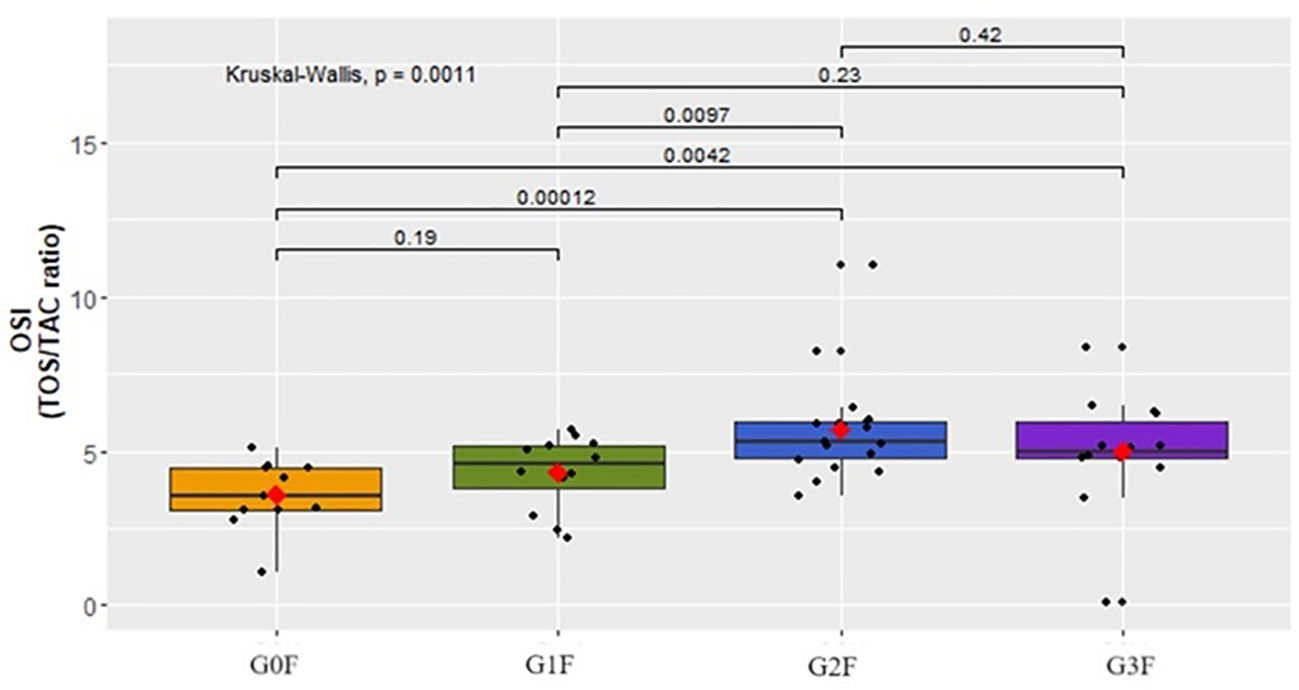
Figure 5 Assessment of the OSI index (TOS/TAC ratio) in the plasma of women in respective groups.
Among women exhibiting suicidal tendencies (G2F: x¯=5.7 ± 1.65, G3F: x¯.0 ± 1.83), a statistically significant elevation in the concentration of the OSI parameter in blood plasma was noted compared to the control group (G0F: x¯=3.6 ± 1.14) (Figure 5). Similarly, the Oxidative Stress Index (OSI) levels were significantly higher in women with suicidal thoughts and a tendency to act on them (G2F: x¯=5.7 ± 1.65) compared to those without such tendencies (G1F: x¯=4.3 ± 1.20).
No analogous distinctions were observed within the male cohort (Figure 6).
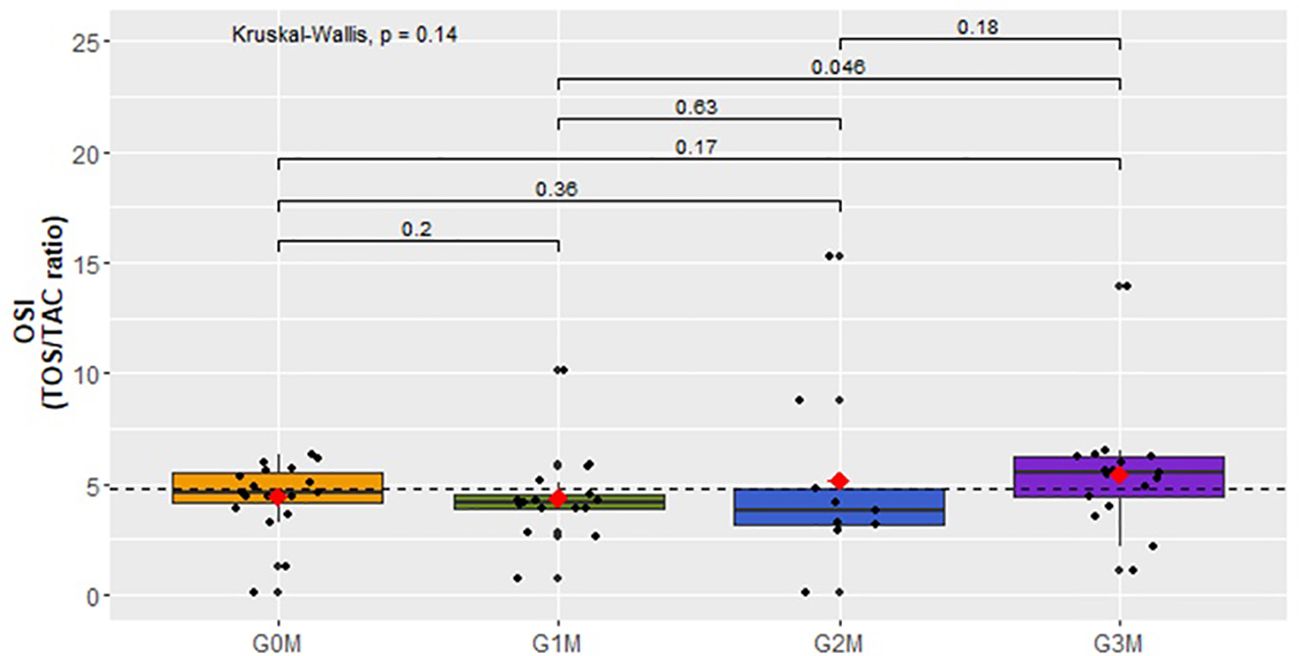
Figure 6 Assessment of the OSI index (TOS/TAC ratio) in the plasma of men in respective groups.
3.2 Antioxidant parameters (GPx, SOD, GSH)Upon analyzing the antioxidant parameters of oxidative stress, statistically significant differences were found in the activity of the GPx parameter in women (p=0.0094) (Figure 7) and in men (p=0.0028) (Figure 8).
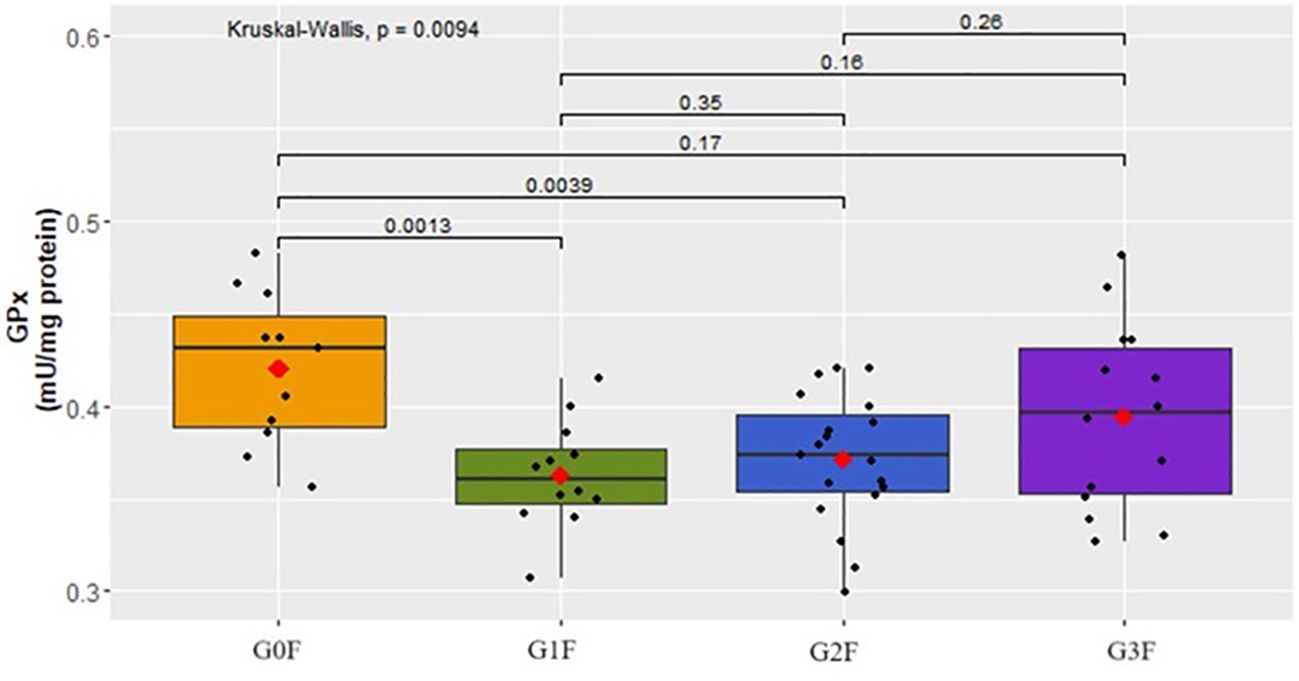
Figure 7 Analysis of GPx activity (mU/mg protein) in the plasma of examined women in respective groups.
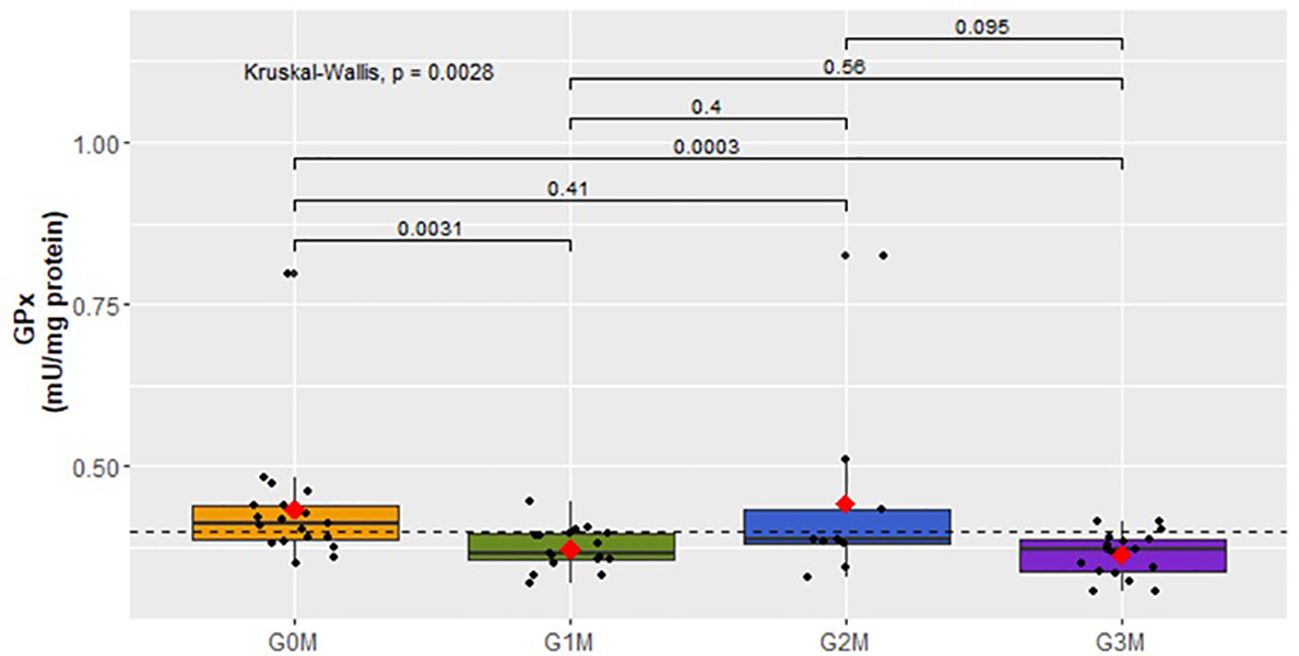
Figure 8 Analysis of GPx activity (mU/mg protein) in the plasma of subjects in respective groups of men.
In the female cohorts, a decline in GPx levels was noted within the groups exhibiting suicidal tendencies (G1F: x¯=0.4 ± 0.03, G2F: x¯=0.4 ± 0.03) in comparison to the control group – G0F x¯(=0.4 ± 0.04) (Figure 7). For the male cohort, a reduction in GPx activity was observed in the G1M x¯(=0.4 ± 0.03) and G3M x¯(=0.4 ± 0.03) groups relative to the G0M control group x¯(=0.4 ± 0.1) (Figure 8).
SOD activity was also analyzed, but statistically significant results were obtained only in the male cohort (p<0,0001). The results are presented in Figure 9.
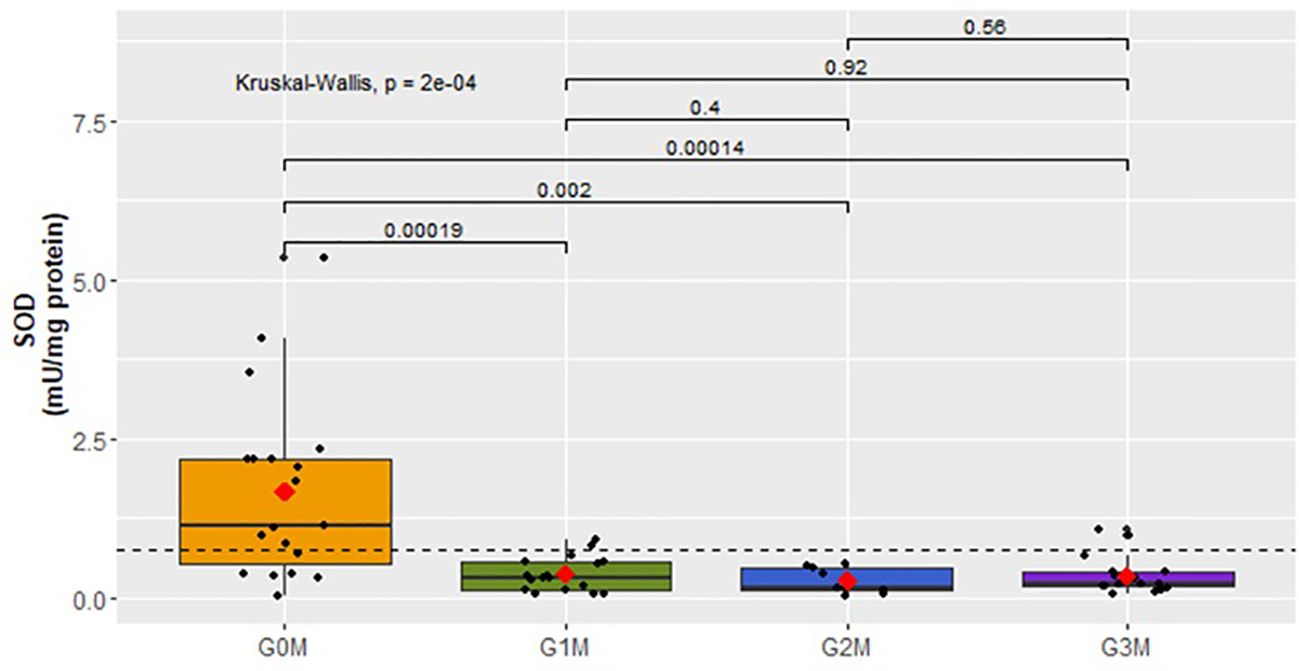
Figure 9 Analysis of SOD activity (mU/mg protein) in plasma in respective male cohorts.
Among the male cohorts, a significant decrease in SOD activity was evidenced in individuals displaying suicidal behavior (G1M: x¯=0.4 ± 0.27), G2M: x¯=0.3 ± 0.20, G3M: x¯=0.3 ± 0.27) compared to patients in the control group (G0M) (Figure 9).
In the female cohorts, the analysis of SOD activity did not show statistically significant differences (Figure 10).
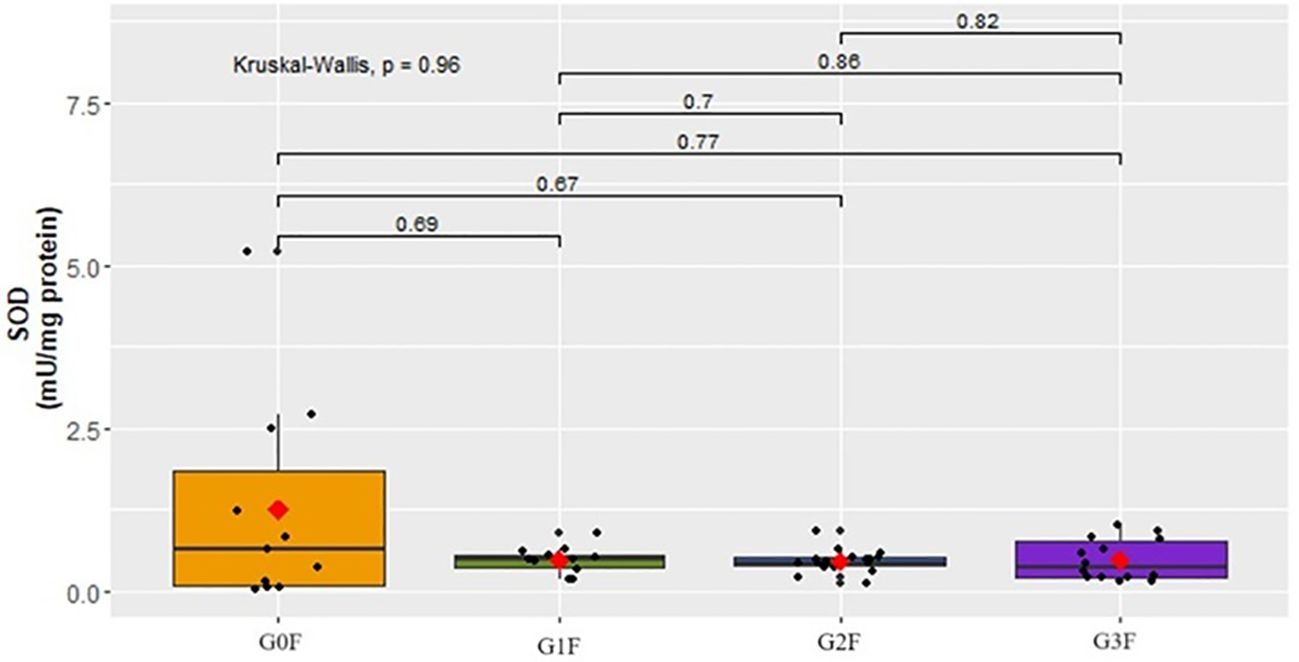
Figure 10 Analysis of SOD activity (mU/mg protein) in plasma in respective groups of female cohorts.
The analysis of the results indicates significant differences between groups of women of the GSH concentration (p=0,036) as shown in Figure 11 (women).
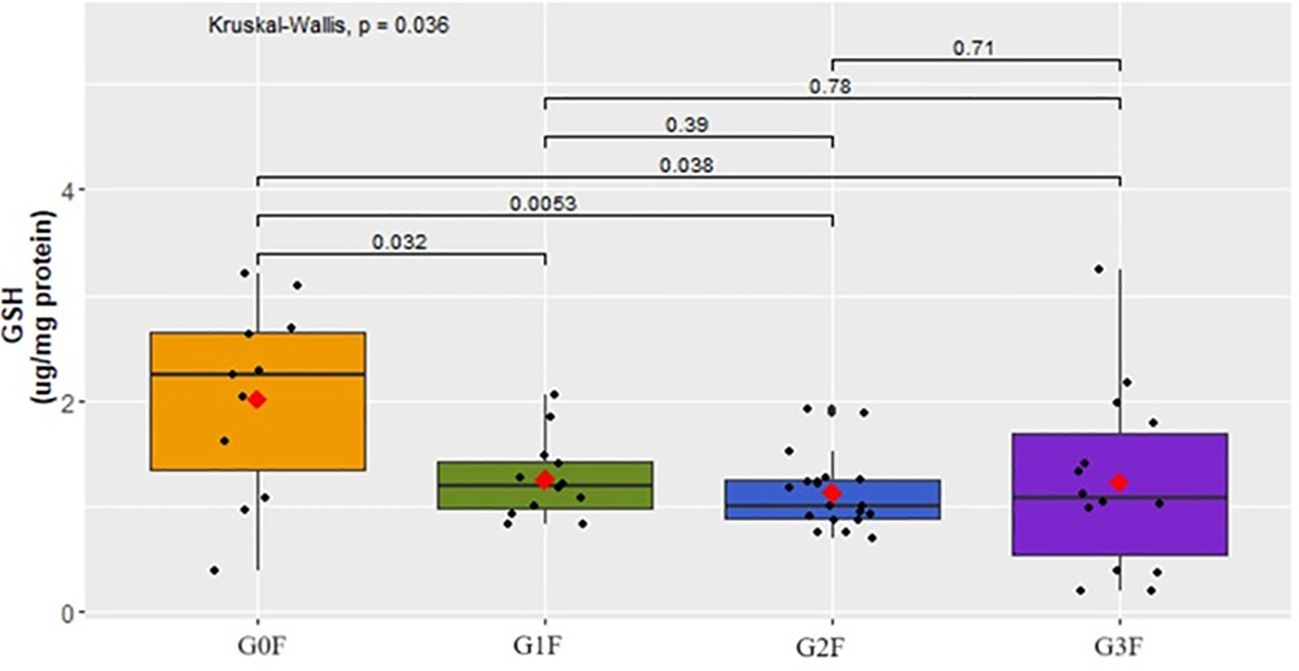
Figure 11 Analysis of GSH concentration (µg/mg protein) in plasma in respective groups of female cohorts.
The examination of GSH concentration in the plasma of the female participants revealed a statistically significant decrease in the groups displaying suicidal behavior (G1F: x¯=1.3 ± 0.38, G2F: x¯=1.1 ± 0.35, G3F: x¯=1.2 ± 0.86) compared to the control group (G0F: x¯=2.0 ± 0.91) (Figure 11). The analysis of the results does not indicates significant differences between groups of men of the GSH concentration (p=0,23). However, only a tendency to decrease the GSH concentration was observed in the group of men after a suicide attempt (G3M: x¯=1.12 ± 0.54) compared to men from the control group (G0M: x¯=1.98 ± 1.67) (Figure 12).
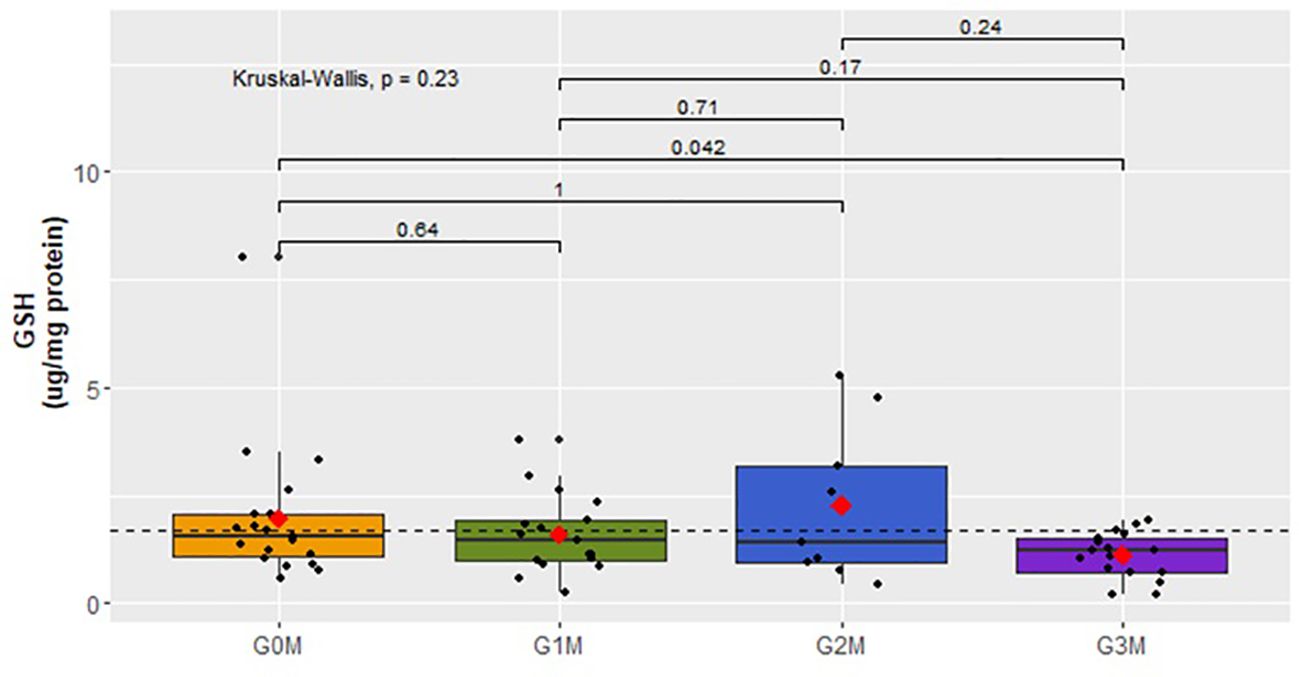
Figure 12 Analysis of GSH concentration (µg/mg protein) in plasma in respective male cohorts.
CAT, TAC and FRAP parameters were also analyzed but no statistically significant differences were observed. The summary results are presented in Table 2.
4 DiscussionOxidative stress factors are considered determinants of suicidal behaviors. A growing body of research is presenting evidence indicating the association between specific mental disorders (such as severe depression, autism spectrum disorders, and anxiety disorders) and irregularities in oxidative stress parameters.
Our study suggests an elevation in the levels of TOS and OSI in the plasma of surveyed women as the intensity of suicidal thoughts increases. This correlation is not evident in the group of men. However, an escalation in the concentration of TOS and OSI is noted in groups exhibiting higher levels of suicidal behavior, irrespective of gender. This finding aligns with outcomes from other studies. Koweszko et al. reported an upsurge in the OSI index among patients with suicidal thoughts over the past three months compared to those who did not report such thoughts during this period (5). While their study encompassed both women and men without distinguishing suicidal thoughts based on their likelihood of realization, our research additionally revealed an increase in OSI and TOS concentrations in the group of women with suicidal thoughts tending towards acting upon them, compared to those without such tendencies. This observation suggests a rise in these parameters in tandem with heightened suicidal tendencies.
A decrease in GPx activity in the body leads to the accumulation of reactive oxygen species (ROS) and amplifies autonomous symptoms of depression. Moreover, GPx plays a protective role against neuronal and DNA damage, as well as cell death (17). Our research, focusing on antioxidant parameters, revealed statistically significant differences in GPx activity across groups of women and men, as well as in the combined analysis without gender division. Activity reduction was observed in groups exhibiting suicidal behavior compared to the control group (without suicidal tendencies). This suggests an increased GPx metabolism in the presence of suicidal tendencies. Contrarily, Loo JL’s study did not show statistically significant differences in GPx activity in the group of patients with suicidal thoughts when compared to the control group, with no consideration for the sex of individuals with bipolar disorder (3). Similar non-significant results were obtained in the analysis of SOD activity (3). Our research, however, indicated a significant decrease in SOD activity in both the combined analysis without sex division and in the groups of men. This reduction was observed in all male groups exhibiting suicidal tendencies compared to the control group. In Vaváková’s study, involving patients of both sexes suffering from depression, the obtained results for SOD activity indicated both an increase and a decrease in this parameter’s activity in blood plasma (17). Meanwhile, Oshnokhah et al. compared the activity of NO, SOD, and TAC in blood plasma and showed a statistically significant decrease in SOD and TAC concentration and activity in the group of individuals after a suicidal attempt (7). On the other hand, the TAC concentration results in our study indicated an increase in concentration in groups with suicidal thoughts tending towards acting upon them and in the group after a suicidal attempt. However, this difference was not observed in the analysis that included separate cohorts of women and men.
The presence of major depressive disorder (MDD) is linked not only to heightened oxidative damage but also to diminished protection against oxidation. This is associated with elevated cortisol levels and reduced activity of GPx1 and SOD, leading to damage to the nerve cells. Studies by Chandley et al. underscore this correlation in patients with MDD who have died by suicide (18).
In individuals with schizophrenia, a reduction in glutathione in the prefrontal cortex and activation of oxidative stress, including GSH deficiency, have been observed (19, 20). Our study scrutinized the decline in GSH concentration in female patients exhibiting suicidal behavior. A statistically significant difference was noted in all three groups of women displaying suicidal behavior compared to the control group and in the analysis encompassing all participants collectively.
Furthermore, our study examined the CAT parameter. The findings do not reveal any statistically significant differences between the groups or in comparison to the control group of patients. However, research conducted by Loo JL indicates a statistically significant elevation in CAT concentration in the blood plasma of patients expressing suicidal thoughts compared to patients diagnosed with bipolar disorder without suicidal thoughts and to the healthy control group (3).
The research conducted by Koweszko et al. and Oshnokhah et al. did not reveal statistically significant differences in FRAP concentration among specific groups of individuals displaying suicidal behavior which is consistent with our results (5, 7).
5 Conclusions● The obtained results suggest that redox biomarkers, namely TOS and OSI, in the blood plasma of women increase in tandem with the severity of suicidal behavior, encompassing both thoughts and attempts. The observation of an elevation in the concentration of these indicators might aid in distinguishing women who genuinely contemplate suicide from those who may not be inclined to act on their expressed suicidal intentions.
● Antioxidant parameters that decline with the onset of suicidal behaviors (thoughts and attempts) may only signify the presence of these tendencies in a given patient, as the observed variations in the concentrations and activity of these parameters were significant solely in comparison to the control group. No notable alterations in SOD, GPx, and GSH concentrations and activity were noted between groups exhibiting suicidal behavior.
● Redox biomarkers TOS and OSI could prove valuable in diagnosing women at a genuine risk of committing suicide. On the other hand, antioxidant parameters – SOD, GPx, and GSH may be instrumental in identifying patients with suicidal behaviors, without specifying their intensity.
Data availability statementThe raw data supporting the conclusions of this article will be made available by the authors, without undue reservation.
Ethics statementThe studies involving humans were approved by the local Bioethics Committee of the Medical University of Białystok, Poland (No: R-I-002/33/2016). The studies were conducted in accordance with the local legislation and institutional requirements. The participants provided their written informed consent to participate in this study.
Author contributionsML: Data curation, Resources, Writing – original draft, Writing – review & editing. LO: Conceptualization, Supervision, Writing – original draft, Writing – review & editing. NW: Conceptualization, Supervision, Writing – review & editing. AK-B: Data curation, Investigation, Resources, Writing – review & editing. MM: Methodology, Supervision, Writing – review & editing. KW-S: Resources, Writing – review & editing. AZ: Methodology, Writing – review & editing. KD: Methodology, Writing – review & editing. MŻ-P: Supervision, Writing – review & editing.
FundingThe author(s) declare financial support was received for the research, authorship, and/or publication of this article. This study was funded by internal sources of the Medical University of Bialystok (project number: N/ST/ZB/17/003/3316).
Conflict of interestThe authors declare that the research was conducted in the absence of any commercial or financial relationships that could be construed as a potential conflict of interest.
Publisher’s noteAll claims expressed in this article are solely those of the authors and do not necessarily represent those of their affiliated organizations, or those of the publisher, the editors and the reviewers. Any product that may be evaluated in this article, or claim that may be made by its manufacturer, is not guaranteed or endorsed by the publisher.
References1. Bhatt M, Perera S, Zielinski L, Eisen RB, Yeung S, El-Sheikh W, et al. Profile of suicide attempts and risk factors among psychiatric patients: A case-control study. PloS One. (2018) 13:e0192998. doi: 10.1371/journal.pone.0192998
PubMed Abstract | CrossRef Full Text | Google Scholar
2. Miola A, Dal Porto V, Tadmor T, Croatto G, Scocco P., Manchia M., et al. Increased C-reactive protein concentration and suicidal behavior in people with psychiatric disorders: A systematic review and meta-analysis. Acta Psychiatrica Scandinavica. (202) 144:537–52. doi: 10.1111/acps.13351
CrossRef Full Text | Google Scholar
3. Loo JL, Mohamad Kamal NA, Goon JA, Ahmad Damanhuri H, Tan JAC, Abdul Murad NA, et al. The role of oxidative stress in suicidal behaviour among bipolar patients: A cross-sectional study in a Malaysian sample. Front Psychiatry. (2021) 12:698911. doi: 10.3389/fpsyt.2021.698911
PubMed Abstract | CrossRef Full Text | Google Scholar
4. Onojighofia Tobore T. On the neurobiological role of oxidative stress in alcohol-induced impulsive, aggressive and suicidal behavior. Subst Use &Misuse. (2019) 54, 14:2290–303. doi: 10.1080/10826084.2019.1645179
CrossRef Full Text | Google Scholar
5. Koweszko T, Gierus J, Zalewska A, Maciejczyk M, Waszkiewicz N, Szulc A. The relationship between suicide and oxidative stress in a group of psychiatric inpatients. J Clin Med. (2020) 9:3462. doi: 10.3390/jcm9113462
PubMed Abstract | CrossRef Full Text | Google Scholar
6. Porter GA, Straud C, O’Connor JC, Knopf KV, Roberts DL. Suicidal ideation across three timepoints in patients discharged from psychiatric hospitalization. Community Ment Health J. (2022) 58:806–11. doi: 10.1007/s10597-021-00889-4
PubMed Abstract | CrossRef Full Text | Google Scholar
7. Oshnokhah M, Bagheri M, Ghaneialvar H, Haghani K, Khorshidi A, Shahbazi A, et al. The role of oxidant-antioxidant status in suicide behavior in kurdish ethnicity. Basic Clin Neurosci. (2021) 12:667–74. doi: 10.32598/bcn.2021.1917.1
PubMed Abstract | CrossRef Full Text | Google Scholar
8. Jiménez-Fernández S, Gurpegui M, Garrote-Rojas D, Gutiérrez-Rojas L, Carretero MD, Correll CU. Oxidative stress parameters and antioxidants in adults with unipolar or bipolar depression versus healthy controls: Systematic review and meta-analysis. J Affect Disord. (2022) 314:211–21. doi: 10.1016/j.jad.2022.07.015
PubMed Abstract | CrossRef Full Text | Google Scholar
9. Upthegrove R, Khandaker GM. Cytokines, oxidative stress and cellular markers of inflammation in schizophrenia. Curr Top Behav Neurosci. (2020) 44:49–66. doi: 10.1007/7854_2018_88
PubMed Abstract | CrossRef Full Text | Google Scholar
11. Falkowski M, Maciejczyk M, Koprowicz T, Mikoluc B, Milewska AJ, Zalewska A, et al. Whey protein concentrate WPC-80 improves antioxidant defense systems in the salivary glands of 14-month wistar rats. Nutrients. (2018) 10:782. doi: 10.3390/nu10060782
PubMed Abstract | CrossRef Full Text | Google Scholar
12. Paglia DE, Valentine WN. Studies on the quantitative and qualitative characterization of erythrocyte glutathione peroxidase. J Lab Clin Med. (1967) 70:158–69.
PubMed Abstract | Google Scholar
13. Misra HP, Fridovich I. The role of superoxide anion in the autoxidation of epinephrine and a simple assay for superoxide dismutase. J Biol Chem. (1972) 247:3170–5. doi: 10.1016/S0021-9258(19)45228-9
PubMed Abstract | CrossRef Full Text | Google Scholar
14. Borys. J, Maciejczyk. M, Antonowicz. B, Krętowski. A, Sidun. J, Domel. E, et al. Glutathione metabolism, mitochondria activity, and nitrosative stress in patients treated for mandible fractures. J Clin Med. (2019) 8, 1:127. doi: 10.3390/jcm8010127
CrossRef Full Text | Google Scholar
15. Erel O. A novel automated direct measurement method for total antioxidant capacity using a new generation, more stable ABTS radical cation. Clin Biochem. (2004) 37:277–85. doi: 10.1016/j.clinbiochem.2003.11.015
PubMed Abstract | CrossRef Full Text | Google Scholar
16. Benzie IF, Strain J. The ferric reducing ability of plasma (FRAP) as a measure of “Antioxidant power”: the FRAP assay. Anal Biochem. (1996) 239:70–6. doi: 10.1006/abio.1996.0292
PubMed Abstract | CrossRef Full Text | Google Scholar
17. Vaváková M, Ďuračková Z, Trebatická J. Markers of oxidative stress an
留言 (0)